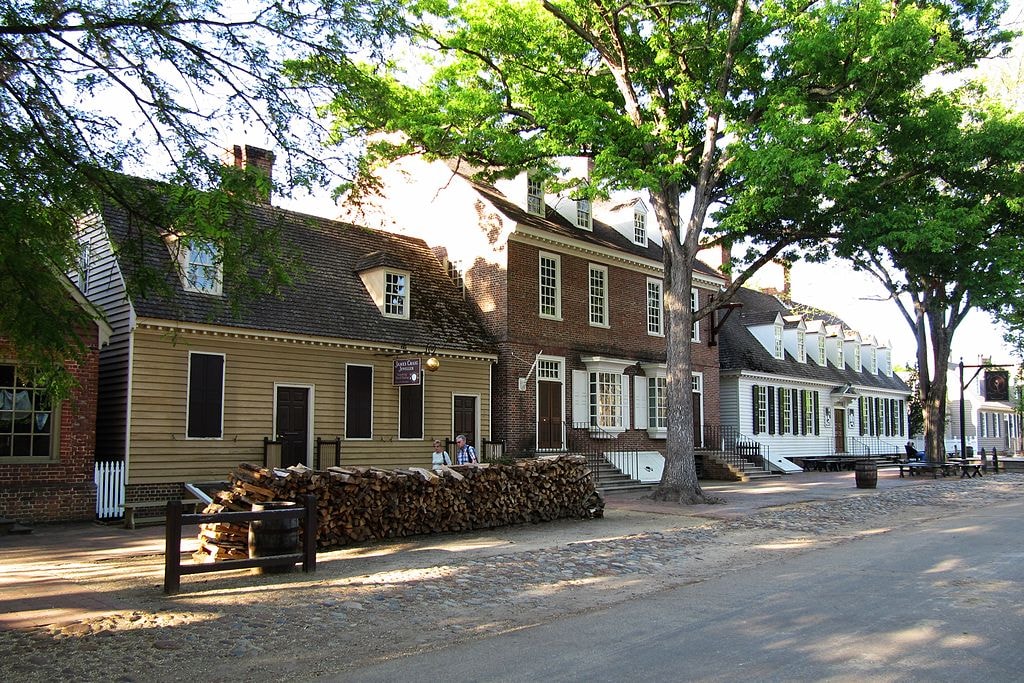“Travel to the 18th century at Virginia’s Thriving Capital City – Williamsburg”
Colonial Williamsburg, the thriving capital of Virginia from 1699 to 1780 presents an exciting era. Virginia was a rich and powerful colony whose boundaries stretched to the mighty Mississippi River and north to the Great Lakes. Virginia’s capital, Williamsburg, the young city of the colonies was the political, cultural and educational center of the most influential American colony.
Colonial Williamsburg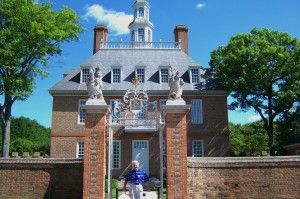 transports you to the 18th century, a time when this dynamic capital was alive with the American dream of freedom and independence. Here you interact in live conversational presentations with influential patriotic leaders including George Washington, Thomas Jefferson, George Mason and Peyton Randolph.
transports you to the 18th century, a time when this dynamic capital was alive with the American dream of freedom and independence. Here you interact in live conversational presentations with influential patriotic leaders including George Washington, Thomas Jefferson, George Mason and Peyton Randolph.
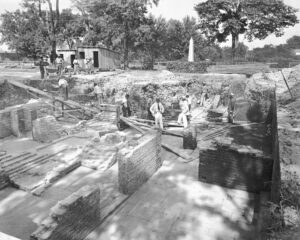
This unique living history museum was the vision of Reverend Dr. W.A.R. Goodwin, Rector of Bruton Parish Church, who dreamed of restoring Williamsburg to its colonial past. Dr. Goodwin shared his dream of preserving the city’s historic buildings with philanthropist John D. Rockefeller Jr. Thanks to Goodwin’s perseverance and the foresight of Rockefeller, Colonial Williamsburg’s, 18th century capital and the ideals of its patriots, who created our American democratic system, live on for future generations. The Visitor Center’s feature film, “The Patriot”, relives the Colonial Williamsburg’s days and the challenges faced by our forefathers in this politically active capital.
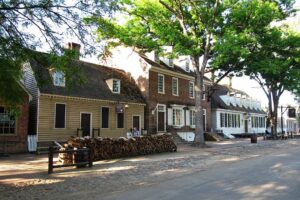
On a sunny spring afternoon, we join an Orientation Tour where a colonial costumed guide gives an overview of Colonial Williamsburg, recommends places to see, the best times to see the most popular attractions and how to make the most of our visit. The Historic Area of Colonial Williamsburg stretches over 301 acres and has 88 original 18th-century structures. Hundreds of houses, shops and public outbuildings are reconstructed on their original foundations. Walking the streets, Williamsburg is experiencing life in the 18th century. We pop in for a colonial style lunch at the restored King’s Arm Tavern with wait staff and hostess in 18th century attire. Afterwards touring the Capitol building the guide explains how the colonists were controlled by the British Monarchs. On the street, we stop at the Wig Makers Shop that displays wigs warn by both men and women. In the Apothecary Shop a highly enthusiastic guide urges visitors to perfectly describe “symptoms” in order to assure the proper drug is prescribed. The apothecary must “fully understand the symptoms”. A tour of the Public Gaol (Jail) shows that prisoners received only basic necessities.
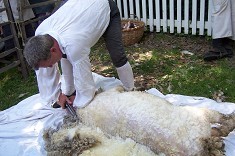
The energy of Colonial Williamsburg is catching as we are immersed into our nation’s past. We stroll the same streets as Thomas Jefferson, George Washington, and Patrick Henry. The costumed interpreters undertake years of study to accurately portray the founding fathers in “first person presentations” every day. We see them in Revolutionary City’s street-theater scenes, or ask questions during “Conversation with a Founding Father” programs. The everyday people in the Historic Area also made contributions and influenced our society, culture, and self-governance. In the Historic Area, we meet servants, farmers, preachers, craftsmen, and shop owners and hear stories of life in this era. We stop and chat with a sheep farmer as he shears a sheep or walk alongside a farmer who guides oxen pulling a wagon with supplies to town.
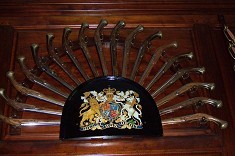
The next day’s plan is to tour the Historic Area of Williamsburg, starting at the most majestic and impressive of the buildings, The Governor’s Palace. Entering the foyer of this beautifully constructed brick building, an amazing 540 guns and swords decorate the Palace. The weapons line the walls in intricate patterns that blend in with the décor. The Palace has housed the early British Governors of Virginia but also the state of Virginia Governors including Patrick Henry and Thomas Jefferson. We wander through the Governor’s Gardens before going into the Palace Kitchen. Here the cook prepares meals for the day. He shares insight into food preparation and types of food served during the 18th century. All the meats are served with their heads in place, i.e. fish, boar. The guide explains that food was always served with the head so that the guests would know what they were eating. Sometimes the fun of tours is getting insight into the little things, too.
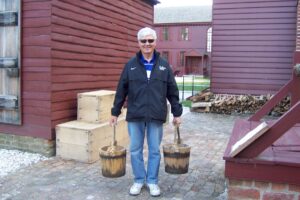
At the George Wythe House, a two-story brick residence, the guide explains Wythe was one of the most influential men of the Revolutionary era. He ranked among colonial America’s finest lawyers, legal scholars, and teachers. In fact Wythe trained Thomas Jefferson and John Marshall in the law. The outbuildings of the Wythe House have costumed ladies weaving, spinning and basket weaving. At the Bruton Parish Church we attend a noon prayer service. Walking the streets, we visit the Courthouse where the Declaration of Independence was read from its steps. Then climb steps of the Magazine that stored equipment for protection against Indians, slaves, riots, and pirates.
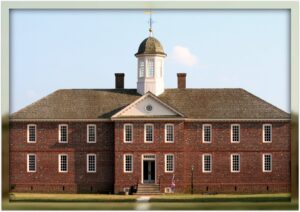
A short walk has us at Merchant Square for a delightful brown bag lunch from The Cheese Shop. Time to do some window shopping and enjoy a stroll on the serene campus of the College of William and Mary, the second college in the American colonies. Stopping at Public Hospital, built in 1773, we learn its history as the first building in North America devoted to the treatment of the mentally ill. Displays show the treatment methods for the mentally ill or insane through the years. Extreme treatments often caused more damage than cure. The Hospital also houses the Abby Aldrich Rockefeller Folk Art Museum and the DeWitt Wallace Decorative Art Museum.
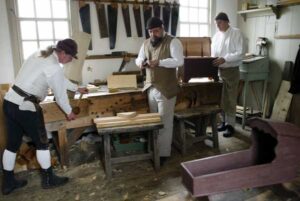
Bang! Buzz! The carpenter is at work in the Carpenter’s Shop and shows how construction was done in the 18th century. Wow, the work and restorations of Colonial Williamsburg are done in the shops using the tools and methods from that era. The carpenter is very proud of the rebuilding of the kitchen of the Peyton Randolph House that matched the historical specifications. In our tour of the Peyton Randolph House, we now appreciate the reconstruction of the house and its buildings. Last stop today is the Cabinetmaker’s Shop. We are impressed with furniture items they made using they produced using the tools and designs of the era.
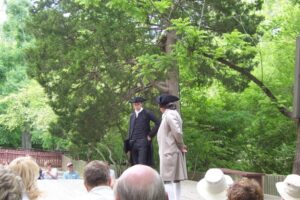
Our third day starts at Wetherburn’s Tavern, which is known for its merriment and conviviality. The tavern was so popular that the owner built an addition called the great room to better accommodate customers. Today’s feature event is the “Conversation with Thomas Jefferson” at the Kimball Theater. The auditorium is packed and Thomas Jefferson takes the stage. He states that he has recently left the presidency and is enjoying his time at Monticello, thus setting the time frame for the discussion. Amazing, astounding and fantastic! The solo performance of the actor captures the essence of this great statesman. Answering questions from the audience, he smoothly handles each question addressing them to that era. We are enthralled with the talent of an individual to have the depth of character portrayed. It is like personally visiting with Jefferson. We then rush to catch the “Conversation with George Washington” at Revolution City. Rains cut this short, so we head to the Visitor Center to see the film on the Rockefellers and their impact on Colonial Williamsburg. A fitting end to our Colonial Williamsburg visit.
Plan a visit!
The Colonial Williamsburg Foundation, P. O. Box 1776, Williamsburg, VA 23187-1776 1-800-HISTORY. www.colonialwilliamsburg.org Note: Do research before arriving to plan your activities. The Historic area is spread out, it is much easier to stroll from building to building than rush from one end to the other. Upon your arrival you will receive the weekly schedule of activities, building openings, and special programs. This is the perfect guide for planning and mapping out your trip. There are also excellent evening programs to enjoy. We visited in May and it was not crowded, however some areas weren’t open. Summer is the busiest season with activities all day long. Williamsburg is great for all ages.
Accommodations: The Woodlands Hotel & Suites sits in a pine grove adjacent to the Colonial Williamsburg’s Visitor Center. The hotel is within walking distance of the Visitor’s Center, shuttle buses, and the historical sites of Colonial Williamsburg. A one bedroom king suite with a separate bedroom and living area providing plenty of room to spread out. Even better, full passes to Colonial Williamsburg and special events are included with our four night hotel package. We definitely recommend the hotel and they also provide a wonderful complimentary breakfast.

